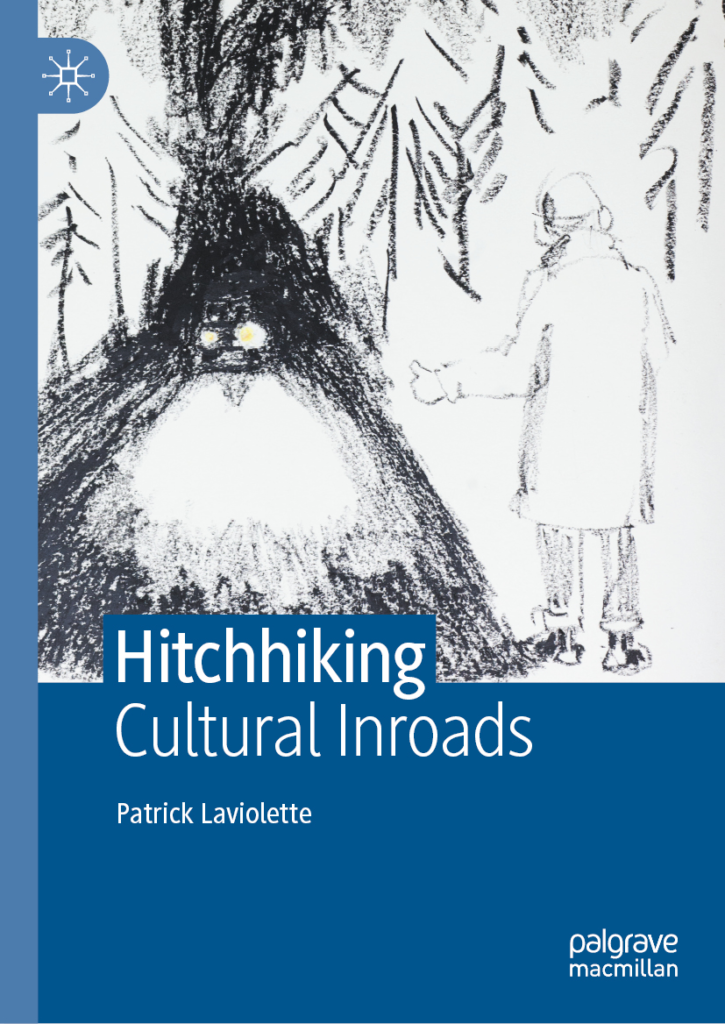Hitchhiking: Cultural Inroads
by Patrick Laviolette
As a travel genre embedded in randomness and adventure, an activity which is effectively an instantiation of pure trusting, hitchhiking inverts many logic structures. That is, it resists the cultures of fear, individualism and neoliberalism. It stands as a retro survivor to the counter-culture movements of the 1960s and 70s. As such a residue, it carries on questioning the status quo, maintaining critical, marginal and liminal edges. Anthropology is a great place from which to examine hitchhiking for several methodological and conceptual reasons. Indeed, it has traditionally been concerned with societies and behaviours that are not just eccentric, but which are often heading towards extinction, or radical transformations that signify the end of their authenticity as unique topics. The book’s introduction provides some reasons as to why this has been the case.

Hitchhiking is often articulated as a flight of fancy, a search for freedom and adventure. Its history runs parallel to that of the motor-car and like this object of capricious consumption can be seen as a manifestation of supreme individualism. Hitching certainly holds ‘dividualistic’ properties in being about opening one’s mind and increasing our levels of mutual tolerance by meeting people on their own terms. It is also about trust, conviviality and other shared experiences. Yet despite all this hitchhiking is often a solo form of travel – hyper driven by the participant’s ego, curiosity, determination and stamina.
Likewise, its decline in the West can be attributed to the perception of living in a world of increased individualism. Amongst other things, drivers are less likely to stop because of a lack of willingness to share their personal space and/or their time. Potential hitchers are less likely to attempt this form of transport because of the desire to travel alone and in a more predictable manner, in the comfort of relatively cheap coaches, trains or planes. Neoliberalism is a main culprit here. We are flooded with online sites offering the option of co-sharing anything under the sun. The sharing craze is a lucrative industry, which at its best helps reduce congestion, provides employment, standardises services against certain risks. At its worse, it relies on little more than app. platforms that allow some users to flog their hand-me-downs to customers who unwittingly nab up inferior services/products. Toying with the notion of the total social fact/fiction, the second chapter examines these paradoxes through cases illustrating the lighter and darker sides of ride-share/hitchhiking ‘gifts’.
Drawing on material that is both multi-sited and cross-generational, the third chapter (with a contribution from Judith Okely) explores certain socio-political features/paradoxes in hitchhiking. It does so through duo auto-ethnographic considerations for transport infrastructures, fieldwork intimacies and methodological liminality. Hitchhiking overlaps with many bodily, multi-modal forms of ‘carporeal’ displacement. When human bodies are in motion they follow fairly consistent patterns. Anthropologists have preoccupied themselves with such kinetic motilities since the earliest field studies and even before, when second-hand data informed armchair theorising. Yet once it was the participants of the anthropological enterprise who themselves began to take a seat – this time in automatically self-propelled containers – a new fieldsite opened up, one that has not been comprehensively tackled.
Hitchhikers are an increasingly rare breed. As auto-stop’s western frontier dwindles, its eastern extension also slows. Discourses on danger, individualism, marginality and cheap neoliberal alternatives predict the phenomenon’s imminent extinction. We face a complex entangling of road networks no longer designed for people. Yet private, self-driving, autonomous (or driverless) vehicles promise to create a system of freedom and liberation. Grounded in auto-stopping’s many dimensions (i.e. risk, fear and trust, gender, tourism mobility, counter-culture, adventure seeking), the fourth chapter outlines some of the activity’s sites, narratives, eccentricities and embodied affectivities. It challenges current thinking about the organisation of movement, alienation and (auto)mobile materialities, especially by exploring the idea of an accelerated, motorised flâneur.
The fifth chapter uncovers some of the hermeneutic narratives of hitchhiking. By analysing a range of pop-culture examples, it considers poetic, political, filmic and literary themes related to the alternative modalities of thumbing a ride. It also allows us to further question what the relationship is between auto-stop and larger economic transformations such as neoliberalism, the gig economy and recently transforming eco-synergies. Where do ‘slowness’ and sharing fit in? Who are the a(e)ffective characters in designing new economies (financial and moral) instilled by riding with relative strangers? How does auto-stop express explicit and tacit understandings of exchange? When has it helped produce place-sensitive discussions that extend beyond – horizontally stretching our imaginations further afield so that we can see hitchhiking as a global phenomenon?
Hitchhiking provides a particular form of mobility, whereby freely acquired journeys, solicited via the roadside, take on sociological and historiographical significance. Just like many other means of automated transport, hitchhiking relies on road networks. It is nonetheless anomalous in that hitchers rely on more different dimensions of such networks than your average motorist, despite not necessarily contributing to, perhaps even resisting, their normative ideological core. Thumbing a ride is thus by its very character liminal, anti-structural and peri-urban. It demonstrates telling features of non-places, placelessness and the stateless. By arguing that hitchhiking is largely made up of disparate communities of co-opportunistic resistance, the sixth chapter contextualises ethnographically events in 2017 that were part of an effort to sustain this practice in the early 21stcentury. Such a revival exists through race competitions, hitch-gatherings, online publications and other audio/visual/textual accounts.
Other than being quirky, does auto-stopping have any real currency in this century? Even though hitchhikers are not really in it for money, there’s nonetheless a competition element for many of those who see it as a non-competitive ‘sport’. This is not to say that the value implicit in understanding it does not have very real practical and conceptual relevance in better understanding transport networks, environmental concerns, as well as problems dealing with social justice and the equity of distribution in terms of mobility options. At stake are comparative conclusions for improving travel security as well as inquiring into the many possible outcomes when cultural clashes occur in contested vehicle spaces. Moreover, the differences to arise in such risky and rapid moving pressure cooker scenarios can teach us many things about compromise, integration, assimilation and tolerance. The seventh chapter reflects on these issues in relation to the decline yet survival of hitchhiking.
The final chapter questions how breaks with convention, such as those which exist in hitching a lift, impact upon the sensing of place and the encounter with road-scapes. As a travel method, hitching ruptures normative journeys. Destinations are no longer extensions of the present, compelling hitchers to move in intensely free yet highly constrained manners; to seek fleeting physical and mental opportunities. Roads, vehicles and adventure transport are part of those opportunities. Impressionistically inspired, the book’s conclusion provides an existential framework for approaching this fleeting and obscure topic.
And before you think that hitching is irrelevant in the age of COVID-19,
a recent article (30 Oct 2020) in The Washington Post suggests otherwise.
References
Ipavec Miran 2020. Hitchhiking Marathon. 42 countries in 500 Hours. Kanal. Self-Published.
Mahood, Linda 2018. Thumbing a Ride Hitchhikers, Hostels, and Counterculture in Canada. Vancouver: UBC Press.
Reid, Jack 2020. Roadside Americans: The Rise and Fall of Hitchhiking in a Changing Nation. Chapel Hill: Univ. of North Carolina Press.
P.LAVIOLETTE is currently the co-editor of AJECand former co-editor of EASA’s Social Anthropology/Anthropologie Sociale. He is starting an intellectual biography on Raymond Firth as a Resident Fellow of the University of Tartu.
